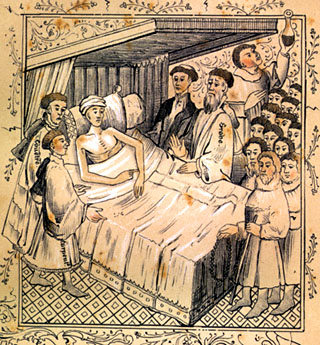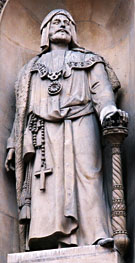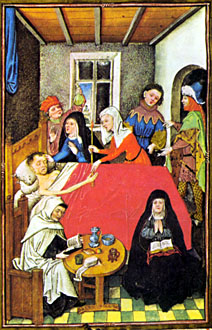
Source: Thomas Brewer, Memoir of the Life and Times
of John Carpenter, London: 1856, facing p.26
This illustration of the former London mayor on his death-bed in 1423 is, for medieval England, a rare depiction. While rendered within a generation after his death (and possibly under the supervision of Carpenter, when he himself was approaching death), we cannot consider the image truly documentary, although some of its features may be accurate.
The differentiation in depiction of his executors – the bearded William Grove on one side of the bed, and younger and clean-shaven John Carpenter and John Coventry on the other side – each of whom is deliberately identified by the illustrator, suggests an attempt to provide at least a rough likeness. Consequently the depiction of Whittington as clean-shaven and balding could also be true to life. It appears to have formed the basis for the best-known but post-medieval depiction of him, but was evidently not known to those who commissioned his statue (below).

This statue of a bearded Richard Whittington,
along the upper level of London's Royal Exchange (Threadneedle Street),
was erected in 1844 when the Exchange was built. Except to the pigeons
that roost there, the existence of the statue is not widely known,
because of its location well above street level.
Photo © S. Alsford
The fourth principal figure at the bedside is a clergyman and likely represents the fourth executor, John White, Whittington's parish priest. On the other hand, the physician at rear examining the patient's urine sample is a conventional representation, seen also in the illustration below, while the group at the foot of the bed represents the residents of the almshouse that was founded in the execution of Whittington's testament. The illustration, which appears on the initial page of the ordinances governing that almshouse (a document in the archives of the Mercers Company), was intended to convey that the almshouse was the result of the express wishes of Whittington to his executors.
 From a Book of Hours made ca.1440
for the Duchess of Guelders: the dying man is flanked by a seated
priest, administering the last rites; beside him a nun or the widow,
praying for his soul. Women on the other side appear to be caregivers
and assist with the last rites. Beyond, the physician examines
urine, and the heir waits to come into his inheritance.
From a Book of Hours made ca.1440
for the Duchess of Guelders: the dying man is flanked by a seated
priest, administering the last rites; beside him a nun or the widow,
praying for his soul. Women on the other side appear to be caregivers
and assist with the last rites. Beyond, the physician examines
urine, and the heir waits to come into his inheritance.